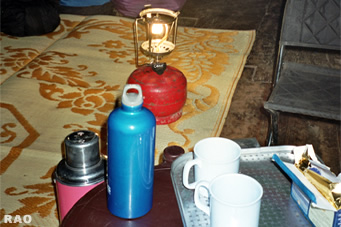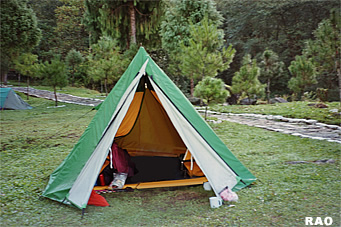 |
Bhutan's
Tourism: Trekking |
 |
Bhutan Information |
|
|
 |
| Trekking:
A long way to go |
 |
 |
| Bhutan
is a trekkers paradise in the Himalayas |
 |
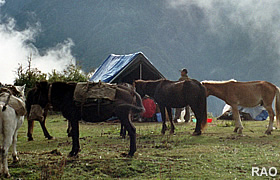 |
| Breath
taking scenery, clean mountain air, lush green valleys, fast flowing mountain
streams - Bhutan is a trekkers paradise in the Himalayas.
But
the number of tourists visiting Bhutan for trekking is, on the contrary,
negligible.
Of
the 13,629 tourists who visited Bhutan in 2005 only 613 tourists came in
for trekking, according to the international tourism monitor, 2005,
released by the tourism department this week. |
|
The
reasons for this incongruity are numerous starting with the lack of
infrastructure and equipment and the hassles and uncertainties involved
during a trek, say tour operators.
top
| Jhomolhari
trek : most popular route |
 |
 |
From
the 613 tourists who came in for trekking about 400 trekked the Jhomolhari
route ( more information), according to tour operators. more information), according to tour operators.
The
gradual terrain, the scenic climb, the view of the Himalayas, and the fact
that it started off from Paro, the main entry and exit point from
Bhutan, were some of the reasons for its popularity with both tourists
and the operators. |
|
The
terrain of the route makes it easier for the tourists to acclimatise, said
a tour operator.
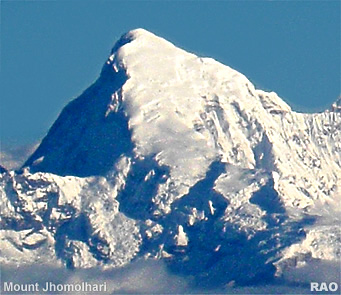 |
| "The
vegetation also changes day by day. The seven day trek starts from about
2,500 metres above sea level and at the end of the third day, it rises
to about 4,100 metres above sea level," he said.
Popularity
has its own adverse effects. With September and October as the most
favored trekking months ( more information) in Bhutan the autumn season usually sees a number
of groups trekking the same route. more information) in Bhutan the autumn season usually sees a number
of groups trekking the same route.
"During
autumn about 15 groups can be seen leaving from Paro," said Jurmin Wangdi
from Yangphel. |
|
top
| Campsites
get crowded |
 |
The
most difficult trek in Bhutan is considered to be 21 days Lunana trek or
the Snowman trek ( more information). more information).
Campsites
also lacked basic facilities like toilets and kitchens and many companies
did not have the resources to invest in specialised trekking gear and equipment.
"The
number of tour operators have been growing but it is only the established
ones that invest in trekking equipment or have the capacity to manage trekking
( more information)," said the managing director of Yangphel Adventure
Travel, Karma Lotey. more information)," said the managing director of Yangphel Adventure
Travel, Karma Lotey.
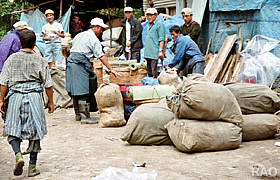 |
| "About
80 percent of the Bhutanese tour operators are new."
Unpredictable
weather conditions, the difficulty in arranging logistics and emergency
situations made it difficult to promote trekking.
"Emergency
helicopter evacuations from the mountains cost about US $ 25,000 a person,"
said Karma Lotey. "The helicopter has to be hired from Nepal at a cost
of US $ 1,200 an hour." |
|
top
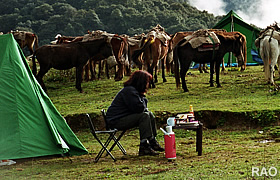 |
| "On
a trek tourists are totally depended on the accompanying staff," he
said, adding that trekkers hit by altitude sickness had to be quickly brought
down to the lower valleys.
Some
tour companies provide the trekking group with a satellite phone on long
treks, oxygen and a pressure bag to deal with altitude sickness attacks.
Arranging horses and yaks for the trek to transport food and equipment
were a major hassle, according to tour operators. |
|
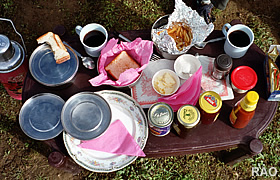 |
| "Sometimes
even though bookings are confirmed months in advance another group takes
the animals," said an operator.
"At
other times the horse contractor starts gathering the animals only when
the group gets there."
At
least 30 horses ( more information) were needed for a group of 16 tourists trekking
for nine days, say tour operators. more information) were needed for a group of 16 tourists trekking
for nine days, say tour operators. |
|
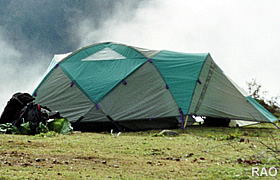 |
| Tour
operators also pointed out that the majority of the tourists visiting Bhutan
were the elderly who had the money but not the energy to walk up the mountains.
According to a tour operator the average age of visiting Bhutan was
about 56 years.
The
younger outdoor type tourists were rare because of the US $ 200 a day tariff.
Only
the cultural trek in Bumthang was suitable for the large majority of tourists
visiting Bhutan. |
|
Most
of the other trek routes were high altitude treks.
Karchung
from Lhomen Tours and Treks said a number of tour operators had come up
in the recent years without understanding fully what it takes to be a tour
operator ( more information). "Just having the license is not enough. One
should be fully equipped and capable of handling tourists." more information). "Just having the license is not enough. One
should be fully equipped and capable of handling tourists."
top
| Very
few Bhutanese trek |
 |
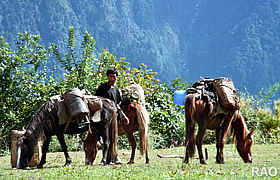 |
| Only
few tourists come to Bhutan on a trekking holiday but even fewer Bhutanese
who live within the grandeur of the Himalayas spend time exploring the
mountainsides.
While
walking is a way of life in many parts of rural Bhutan, the urban Bhutanese
population, which is growing fast, has given in to the comforts and conveniences
of a modern lifestyle. Leisure time is dominated by sports, archery ( more information), gambling and more recently television. more information), gambling and more recently television. |
|
Many
people only have memories of trekking while in school or in college and
walking to school as children. The few who trek when they have the time
say it's worth the walk.
He
added that there were inexperienced guides and cooks taking tourist groups
on their own for trekking, which was not a good trend.
top
But tour
operators agree that trekking has "great" potential. "Bhutan is one
of the least trekked countries in the world and it makes Bhutan exclusive
and attractive," said the general manager of Yangphel Adventure Travel,
Jurmin Wangdi.
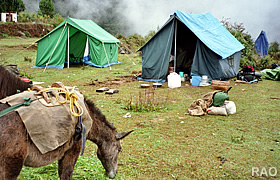 |
| There
are about 20 trekking routes listed by the tourism department of which
nine appear in the Lonely Planet guide. Of these only a few routes
are used, tour operators said.
The
nine-days Chomolhari trek, with its gradual terrain and other advantages
of being near the tourist hotspots, is the most popular route. Tour operators
said that there was a need to develop trekking routes, both old and new
and try to space out the groups trekking the same route so that the campsites
are not crowded. |
|
The
director general of tourism department, Lhatu Wangchuk, said that there
was limited promotion on trekking mainly because the required infrastructure
was not in place.
"In
the past two to three years we have been focusing on plans and policies
but in the Tenth Plan, we will focus on infrastructure and product development,"
said the director general.
The Nabji-Khorphu
trekking route ( more information), which will be a model route and is already being promoted
is to open in October, according to the director general. "The route and
campsites are in the process of being developed," he said. more information), which will be a model route and is already being promoted
is to open in October, according to the director general. "The route and
campsites are in the process of being developed," he said.
Tour
operators said that the Nabji-Khorphu route would be a controlled and monitored
area and it would help promote the awareness of the communities, which
was currently lacking.
| Contributed
by Kinley Wangmo, KUENSEL, Bhutan's National Newspaper, 2006 |
 |
top
| Information on Bhutan |
 |
|







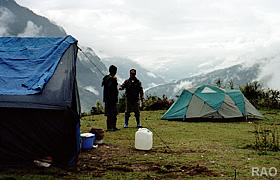
![]() more information).
more information).![]() more information)," said the managing director of Yangphel Adventure
Travel, Karma Lotey.
more information)," said the managing director of Yangphel Adventure
Travel, Karma Lotey.




![]() more information). "Just having the license is not enough. One
should be fully equipped and capable of handling tourists."
more information). "Just having the license is not enough. One
should be fully equipped and capable of handling tourists."


![]() more information), which will be a model route and is already being promoted
is to open in October, according to the director general. "The route and
campsites are in the process of being developed," he said.
more information), which will be a model route and is already being promoted
is to open in October, according to the director general. "The route and
campsites are in the process of being developed," he said.
